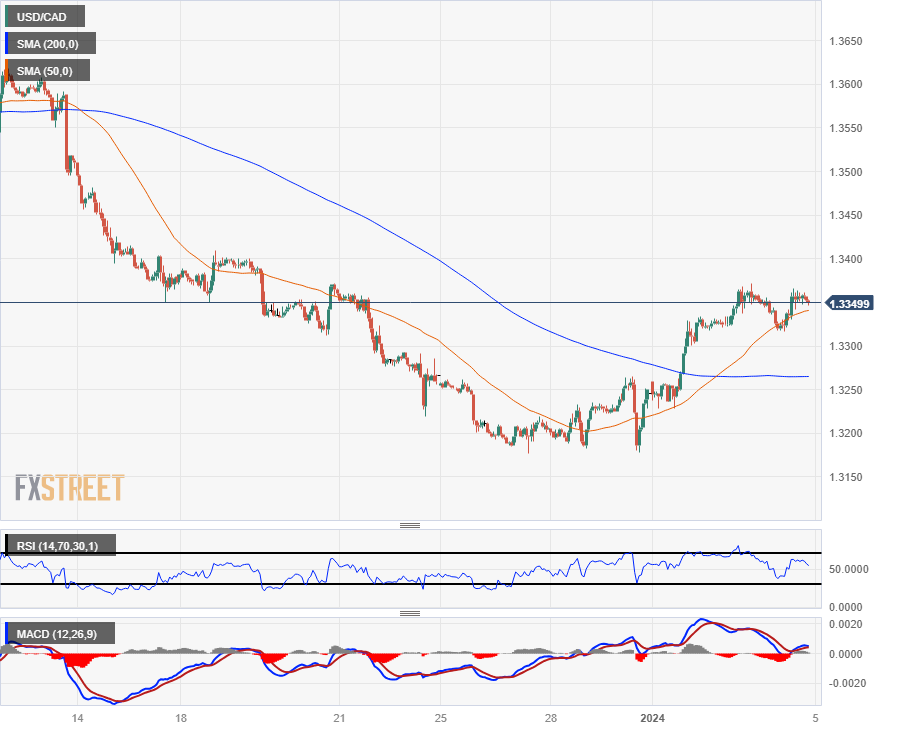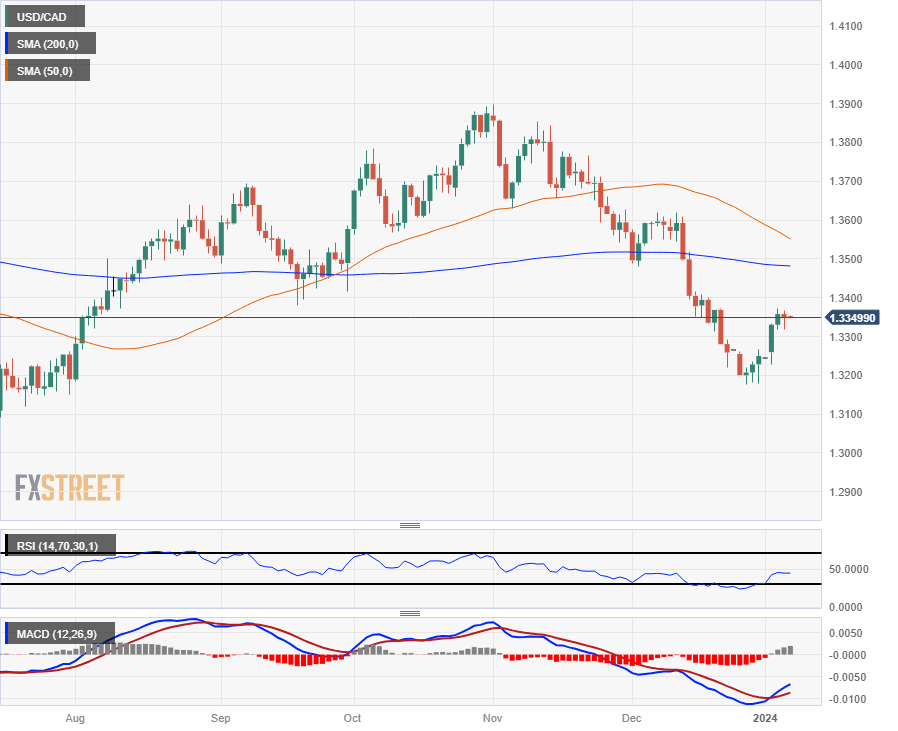Most recent article: Canadian Dollar spins in circles after US NFP beats the market and Canadian jobs additions slump
- The Canadian Dollar is treading water in the back half of the trading week.
- Canada unemployment and wage figures due Friday.
- Friday’s US NFP to overshadow the rest of the market.
The Canadian Dollar (CAD) is mostly flat on Thursday as markets focus elsewhere in the run-up to Friday’s US Nonfarm Payrolls (NFP) print. US datapoints came in broadly above expectations on Thursday, but markets are twisting on the data headlines rather than outright plunging into one direction or the other.
Canada is set to release December’s Unemployment Rate and annualized Average Hourly Wages on Friday, as well as Net Change in Employment numbers, but US NFP numbers will be engulfing market expectations and reactions to round out the first trading week of 2024. An unexpected surge in ADP US jobs data has markets making last-minute adjustments to Friday’s NFP forecast, but the widening discrepancy between ADP and NFP headline prints is muddying the waters and turning correlative forecasting into a bit of an exercise in throwing darts at a board.
Daily digest market movers: Canadian Dollar sticking close to Thursday’s opening bids
- Canadian Dollar is largely flat against its key counterpart, the US Dollar (USD), on Thursday.
- The Loonie is a mixed bag with the CAD down a fifth of a percent against the Euro (EUR) and one-tenth of one percent against the Pound Sterling (GBP).
- On the high side, the Canadian Dollar has gained nearly half of a percent against the Aussie (AUD) and a third of a percent against the Kiwi (NZD), with the Yen (JPY) shedding 1.1% against the Loonie.
- US ADP Employment Change surged in December, showing a net addition of 164K thousand jobs versus the forecast 115K and handily clearing November’s print of 101K (revised down from 103K).
- US Initial Jobless Claims for the week ended December 29 also beat expectations, declining to 202K versus the forecast 216K, slipping even further back from the previous week’s 220K new jobless benefits seekers (revised upwards from 218K).
- The bumper ADP print is encouraging on-edge investors to adjust NFP Friday forecasts higher, with the median NFP forecast currently expecting 170K new jobs on the headline December print compared to November’s 199K.
- The Canadian Unemployment Rate is expected to tick slightly higher from 5.8% to 5.9% in December, while Average Hourly Wages for the year ended December last showed 5% growth, with no consistent forecast on the books.
- Canadian Employment Change in December is expected to show 13.5K net new jobs compared to the previous month’s 24.9K.
Canadian Dollar price today
The table below shows the percentage change of Canadian Dollar (CAD) against listed major currencies today. Canadian Dollar was the strongest against the Japanese Yen.
| USD | EUR | GBP | CAD | AUD | JPY | NZD | CHF | |
| USD | -0.20% | -0.06% | 0.02% | 0.47% | 1.14% | 0.31% | 0.11% | |
| EUR | 0.19% | 0.13% | 0.21% | 0.66% | 1.33% | 0.50% | 0.30% | |
| GBP | 0.06% | -0.14% | 0.07% | 0.53% | 1.20% | 0.38% | 0.18% | |
| CAD | -0.01% | -0.20% | -0.07% | 0.46% | 1.13% | 0.30% | 0.14% | |
| AUD | -0.47% | -0.67% | -0.53% | -0.46% | 0.68% | -0.16% | -0.35% | |
| JPY | -1.17% | -1.35% | -1.23% | -1.15% | -0.70% | -0.85% | -1.04% | |
| NZD | -0.32% | -0.52% | -0.38% | -0.29% | 0.15% | 0.83% | -0.20% | |
| CHF | -0.13% | -0.32% | -0.18% | -0.11% | 0.35% | 1.01% | 0.20% |
The heat map shows percentage changes of major currencies against each other. The base currency is picked from the left column, while the quote currency is picked from the top row. For example, if you pick the Euro from the left column and move along the horizontal line to the Japanese Yen, the percentage change displayed in the box will represent EUR (base)/JPY (quote).\
Technical Analysis: Canadian Dollar braces for NFP Friday, USD/CAD grinds to a halt near 1.3350
2024 kicked off with markets sending the Canadian Dollar (CAD) lower against the US Dollar, but the USD/CAD is pumping the brakes as investors gear up for Friday’s NFP showdown. Intraday action caught a clean bounce from the 50-hour Simple Moving Average (SMA) just above 1.3320 in early Thursday trading, and the pair is sticking close to near-term highs.
The USD/CAD is up around 0.8% from the week’s opening bids of 1.3260, and the near-term technical ceiling is currently parked at the 1.3400 handle with support coming from the bottom end of the consolidation zone clustered around 1.3200.
The USD/CAD has chalked in five consecutive days of gains, dragging the pair back towards the 200-day SMA just below 1.3500.
USD/CAD Hourly Chart

USD/CAD Daily Chart

Canadian Dollar FAQs
What key factors drive the Canadian Dollar?
The key factors driving the Canadian Dollar (CAD) are the level of interest rates set by the Bank of Canada (BoC), the price of Oil, Canada’s largest export, the health of its economy, inflation and the Trade Balance, which is the difference between the value of Canada’s exports versus its imports. Other factors include market sentiment – whether investors are taking on more risky assets (risk-on) or seeking safe-havens (risk-off) – with risk-on being CAD-positive. As its largest trading partner, the health of the US economy is also a key factor influencing the Canadian Dollar.
How do the decisions of the Bank of Canada impact the Canadian Dollar?
The Bank of Canada (BoC) has a significant influence on the Canadian Dollar by setting the level of interest rates that banks can lend to one another. This influences the level of interest rates for everyone. The main goal of the BoC is to maintain inflation at 1-3% by adjusting interest rates up or down. Relatively higher interest rates tend to be positive for the CAD. The Bank of Canada can also use quantitative easing and tightening to influence credit conditions, with the former CAD-negative and the latter CAD-positive.
How does the price of Oil impact the Canadian Dollar?
The price of Oil is a key factor impacting the value of the Canadian Dollar. Petroleum is Canada’s biggest export, so Oil price tends to have an immediate impact on the CAD value. Generally, if Oil price rises CAD also goes up, as aggregate demand for the currency increases. The opposite is the case if the price of Oil falls. Higher Oil prices also tend to result in a greater likelihood of a positive Trade Balance, which is also supportive of the CAD.
How does inflation data impact the value of the Canadian Dollar?
While inflation had always traditionally been thought of as a negative factor for a currency since it lowers the value of money, the opposite has actually been the case in modern times with the relaxation of cross-border capital controls. Higher inflation tends to lead central banks to put up interest rates which attracts more capital inflows from global investors seeking a lucrative place to keep their money. This increases demand for the local currency, which in Canada’s case is the Canadian Dollar.
How does economic data influence the value of the Canadian Dollar?
Macroeconomic data releases gauge the health of the economy and can have an impact on the Canadian Dollar. Indicators such as GDP, Manufacturing and Services PMIs, employment, and consumer sentiment surveys can all influence the direction of the CAD. A strong economy is good for the Canadian Dollar. Not only does it attract more foreign investment but it may encourage the Bank of Canada to put up interest rates, leading to a stronger currency. If economic data is weak, however, the CAD is likely to fall.
Information on these pages contains forward-looking statements that involve risks and uncertainties. Markets and instruments profiled on this page are for informational purposes only and should not in any way come across as a recommendation to buy or sell in these assets. You should do your own thorough research before making any investment decisions. FXStreet does not in any way guarantee that this information is free from mistakes, errors, or material misstatements. It also does not guarantee that this information is of a timely nature. Investing in Open Markets involves a great deal of risk, including the loss of all or a portion of your investment, as well as emotional distress. All risks, losses and costs associated with investing, including total loss of principal, are your responsibility. The views and opinions expressed in this article are those of the authors and do not necessarily reflect the official policy or position of FXStreet nor its advertisers. The author will not be held responsible for information that is found at the end of links posted on this page.
If not otherwise explicitly mentioned in the body of the article, at the time of writing, the author has no position in any stock mentioned in this article and no business relationship with any company mentioned. The author has not received compensation for writing this article, other than from FXStreet.
FXStreet and the author do not provide personalized recommendations. The author makes no representations as to the accuracy, completeness, or suitability of this information. FXStreet and the author will not be liable for any errors, omissions or any losses, injuries or damages arising from this information and its display or use. Errors and omissions excepted.
The author and FXStreet are not registered investment advisors and nothing in this article is intended to be investment advice.
Recommended content
Editors’ Picks

EUR/USD stays near 1.0400 in thin holiday trading
EUR/USD trades with mild losses near 1.0400 on Tuesday. The expectation that the US Federal Reserve will deliver fewer rate cuts in 2025 provides some support for the US Dollar. Trading volumes are likely to remain low heading into the Christmas break.

GBP/USD struggles to find direction, holds steady near 1.2550
GBP/USD consolidates in a range at around 1.2550 on Tuesday after closing in negative territory on Monday. The US Dollar preserves its strength and makes it difficult for the pair to gain traction as trading conditions thin out on Christmas Eve.

Gold holds above $2,600, bulls non-committed on hawkish Fed outlook
Gold trades in a narrow channel above $2,600 on Tuesday, albeit lacking strong follow-through buying. Geopolitical tensions and trade war fears lend support to the safe-haven XAU/USD, while the Fed’s hawkish shift acts as a tailwind for the USD and caps the precious metal.

IRS says crypto staking should be taxed in response to lawsuit
In a filing on Monday, the US International Revenue Service stated that the rewards gotten from staking cryptocurrencies should be taxed, responding to a lawsuit from couple Joshua and Jessica Jarrett.

2025 outlook: What is next for developed economies and currencies?
As the door closes in 2024, and while the year feels like it has passed in the blink of an eye, a lot has happened. If I had to summarise it all in four words, it would be: ‘a year of surprises’.

Best Forex Brokers with Low Spreads
VERIFIED Low spreads are crucial for reducing trading costs. Explore top Forex brokers offering competitive spreads and high leverage. Compare options for EUR/USD, GBP/USD, USD/JPY, and Gold.